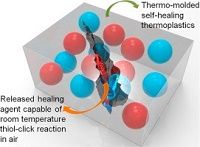pvc-asso.ir
PVC-composite self-heals in response to mechanical damage
 The promise of self-healing thermoplastic materials may be one step closer, thanks to recent work from Chinese researchers.
The promise of self-healing thermoplastic materials may be one step closer, thanks to recent work from Chinese researchers.
Thermoplastics are used in countless consumer products because of their adaptability – they can be heated and shaped many times, before causing any degradation in the material structure. Found in everything from shoe soles to water pipes, polyvinyl chloride (PVC) is one of the most widely used thermoplastic materials. But, until recently, it lagged behind on the latest research trend in polymers – no-one had managed to make PVC that could self-heal.
Polymers containing microencapsulated healing agents have been a focal point of self-healing materials over the past decade. But in the latest issue of Polymer [DOI:10.1016/j.polymer.2015.05.052], Ming Qiu Zhang and his team have taken this approach one a step further.
They report, for the first time, on the use of “click chemistry” to produce a PVC-composite that automatically self-heals in response to mechanical damage. Rather than referring to a single reaction, click chemistry is the name given to a range of highly-efficient chemical processes that generate products by joining small units together. And they do this quickly, at ambient temperature and in atmospheric conditions.
Zhang’s approach used thiol-click chemistry to produce a self-healing PVC composite. Two distinct components of a healing agent were encapsulated separately, before being added to powdered PVC and compression-moulded into testable samples.
These composites were then impacted to failure at room temperature. With the application of pressure (0.2 MPa), both sides of the crack were brought together, where the healing agent reacted and bonded the crack. After 2-3 hours, the healed specimen was impacted to failure again, with the healing efficiency defined as the ratio between the two impact strengths. Results showed that across the crack, highly cross-linked networks formed between the healing agent’s components and the PVC. Increasing the capsule concentration improved the composite’s healing efficiency, but decreased its impact strength, so further work to optimise the ratio of capsule-to-PVC powder is ongoing.
These results suggest that it is possible recover much of the mechanical strength of a damaged PVC composite, autonomously, rapidly and at room temperature in air, using click-chemistry. This has not only contributed to our knowledge of self-healing materials, but may have wider implications across the broader family of thermo-formable plastics.
Dong Yu Zhu et al, Polymer (2015) 69, 1-9 “Self-healing polyvinyl chloride (PVC) based on microencapsulated nucleophilic thiol-click chemistry.”
Source: materialstoday
.gif)
.gif)

نظرات